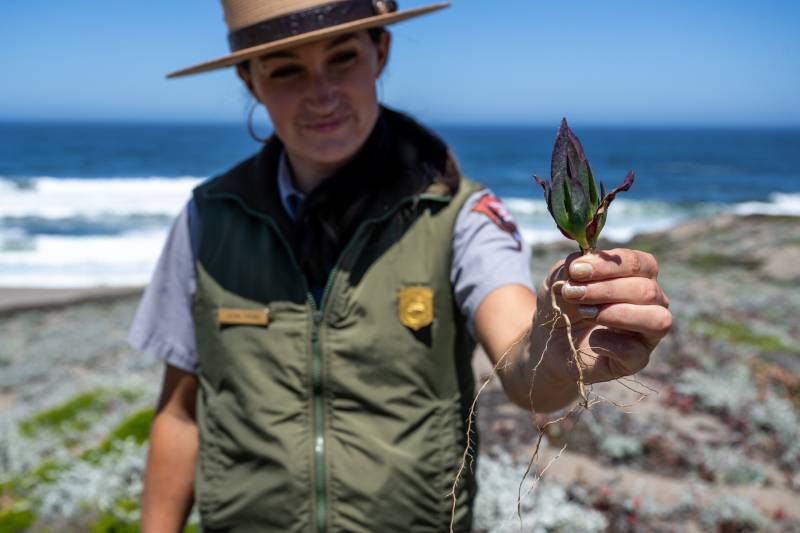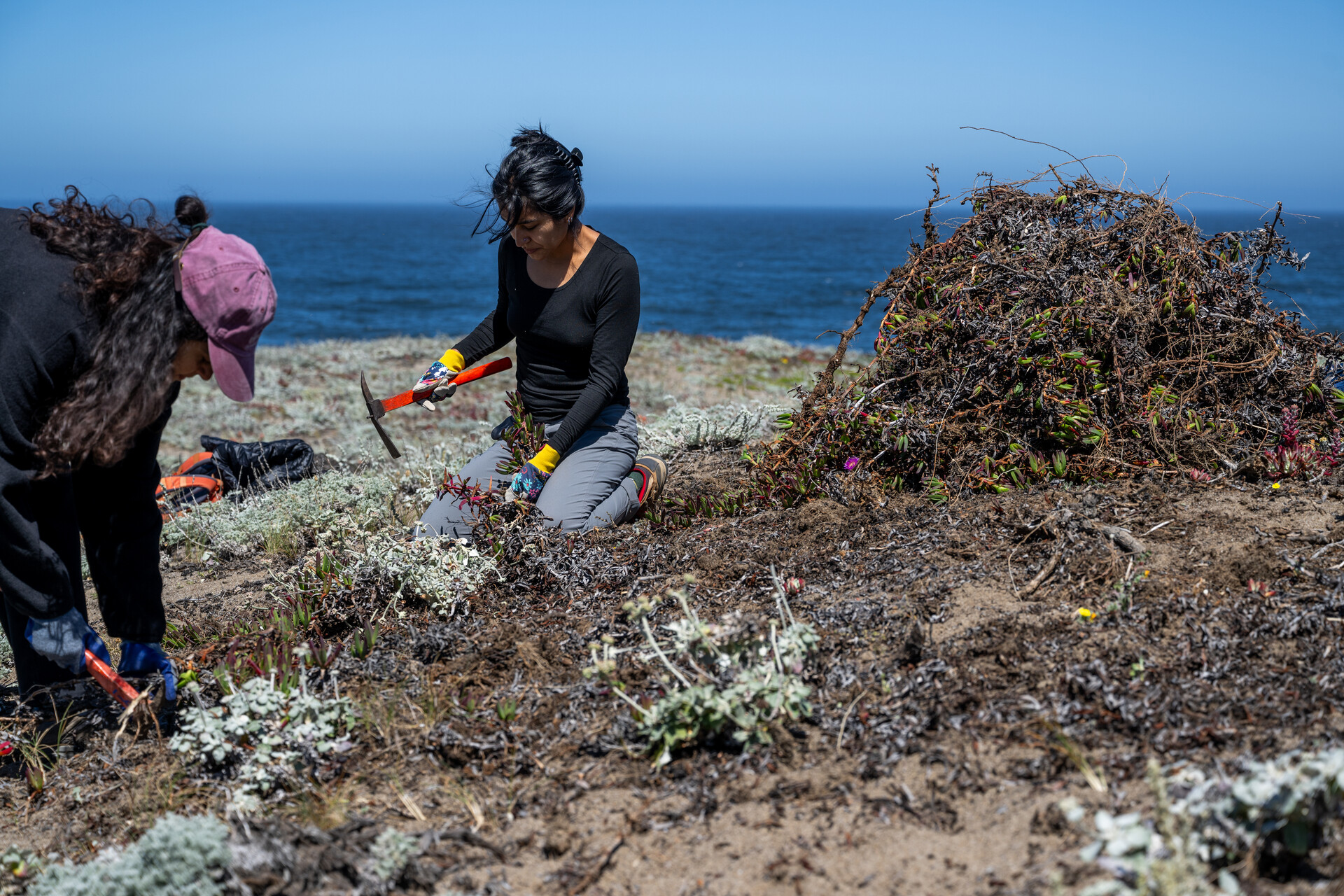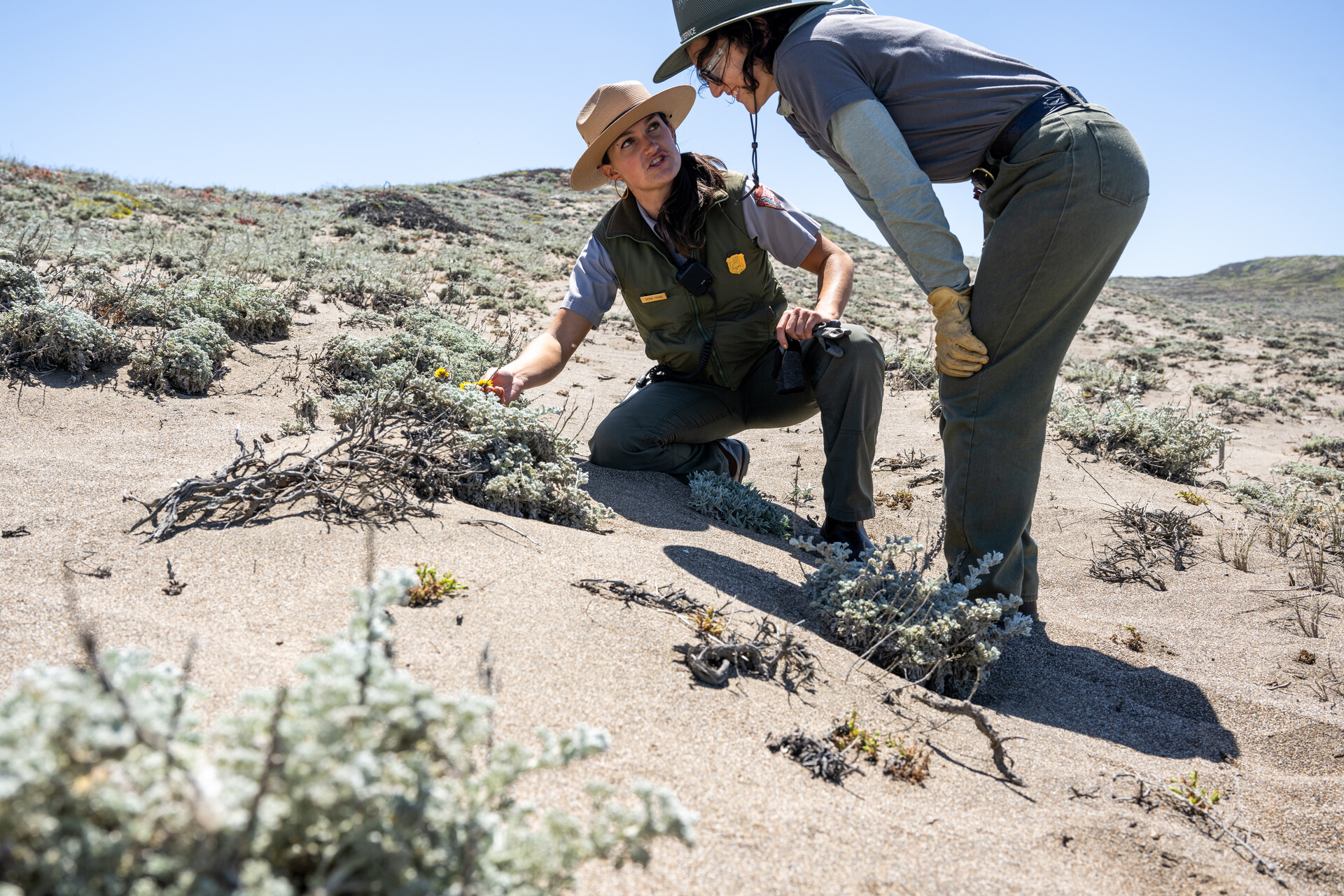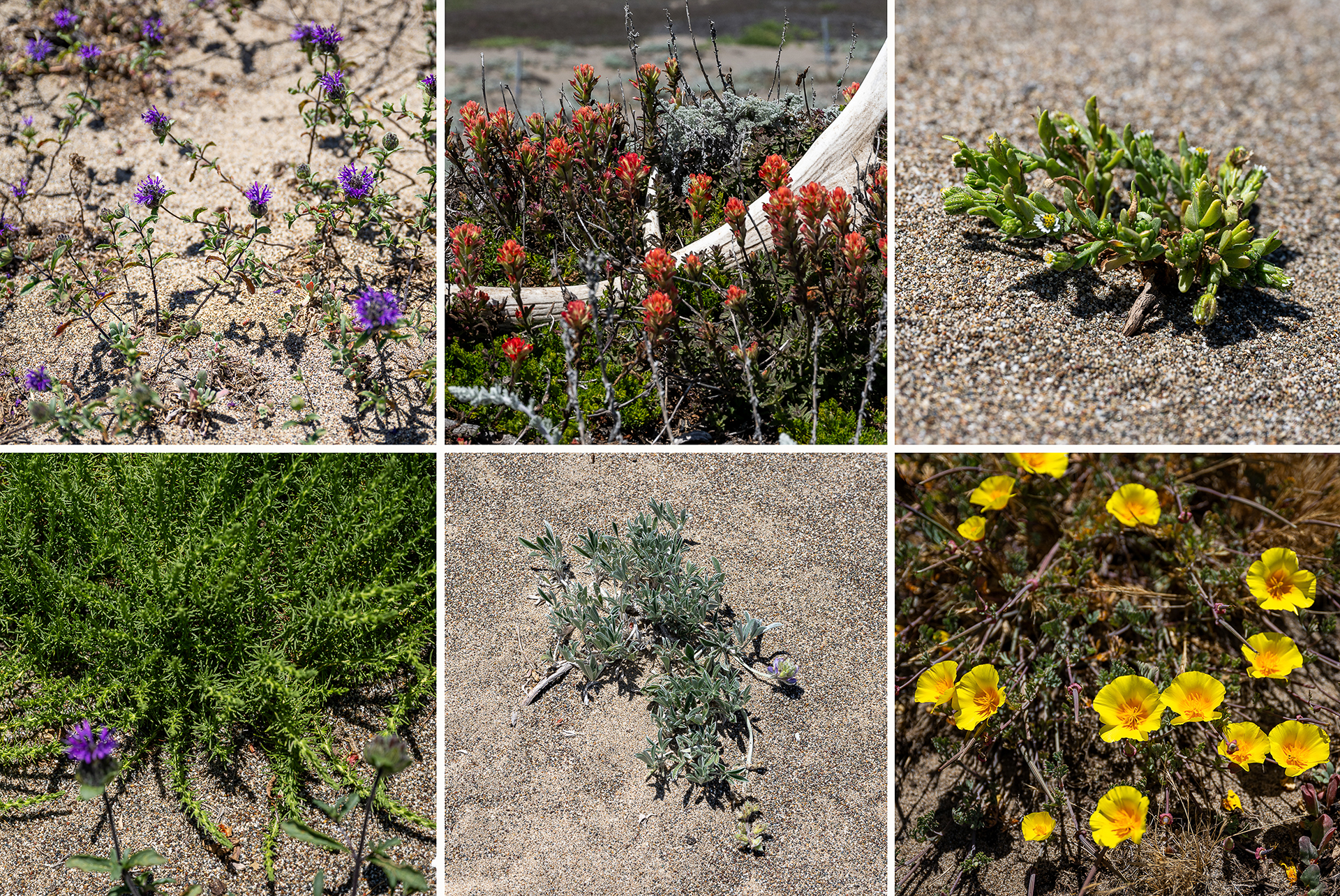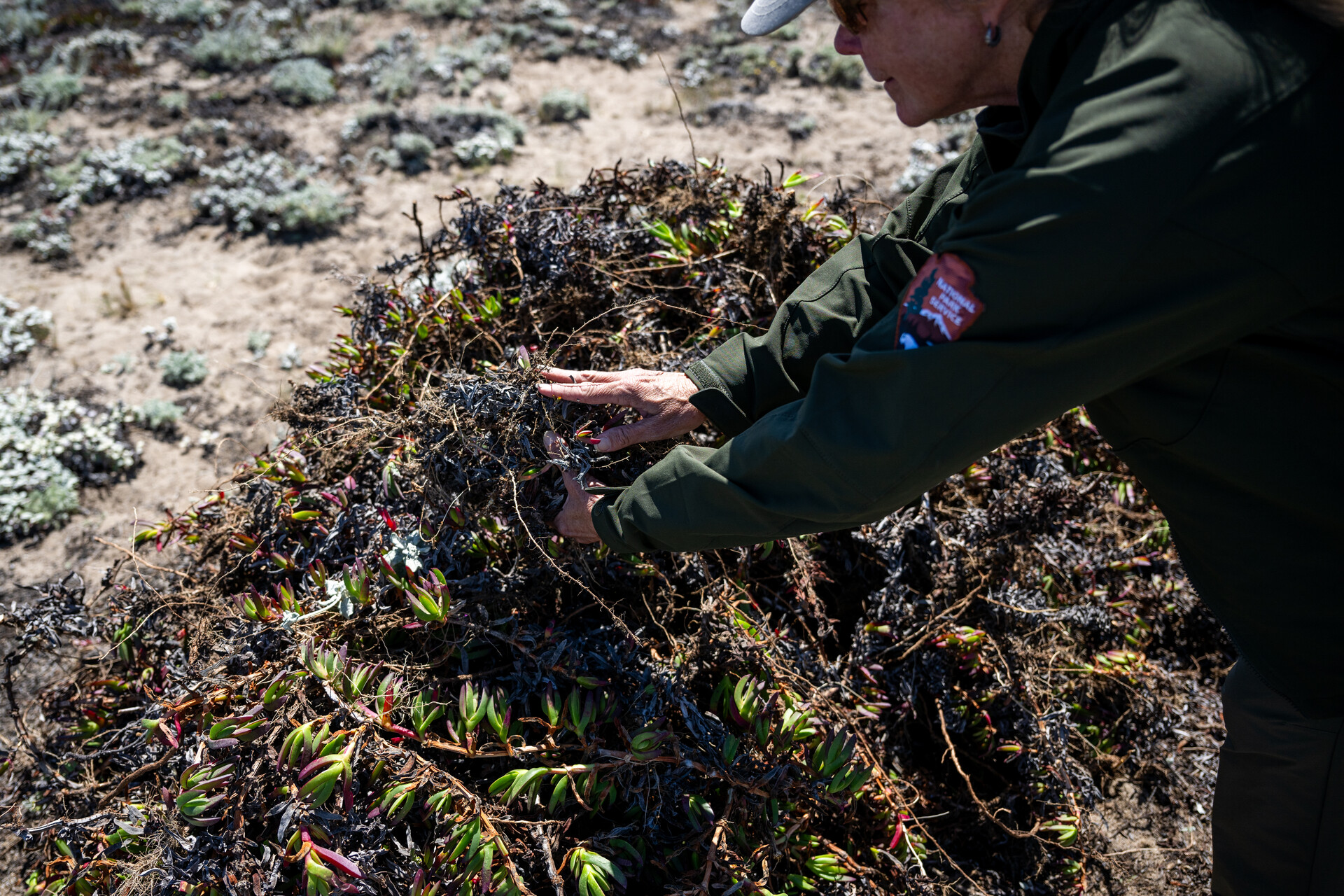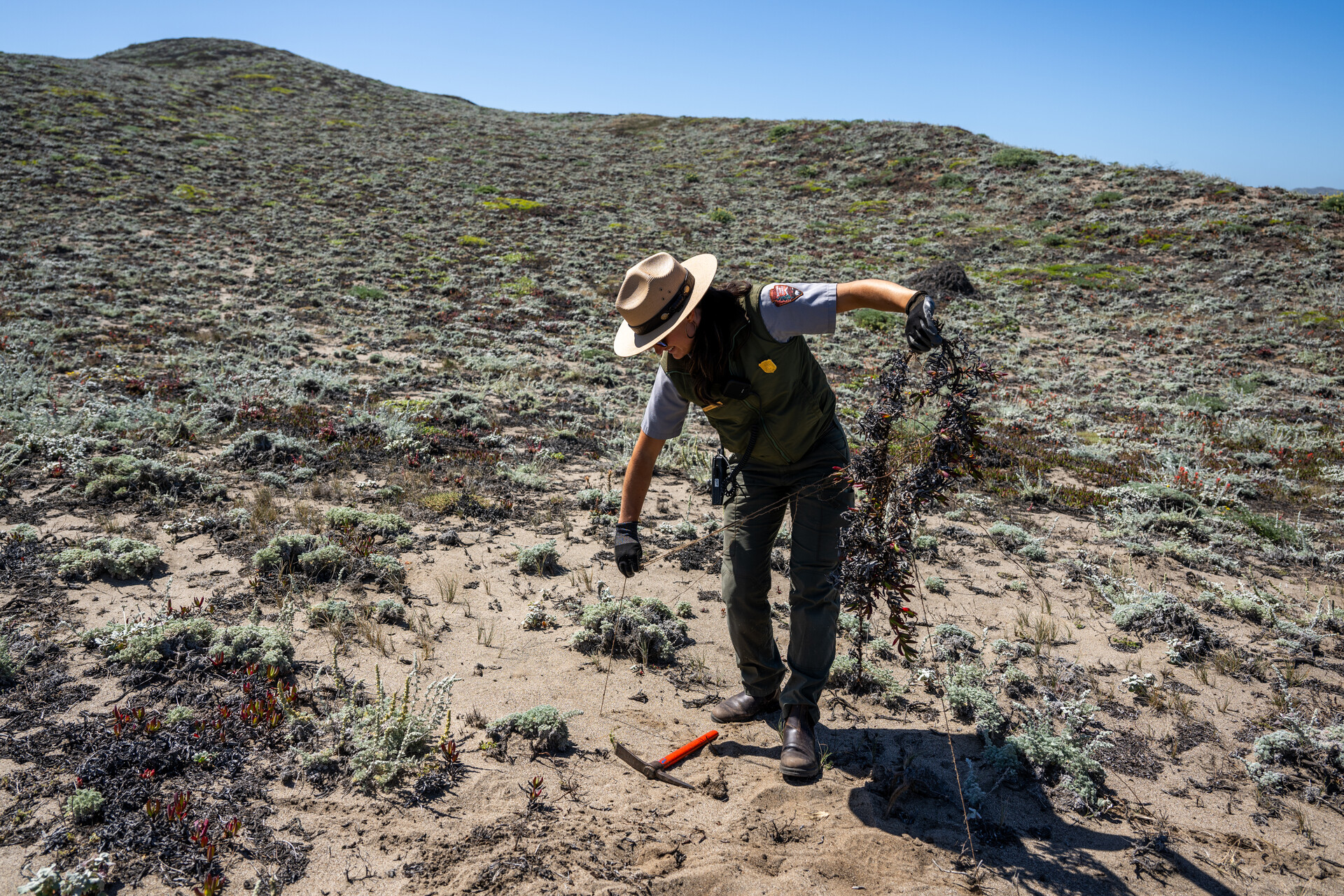Episode Transcript
This is a computer-generated transcript. While our team has reviewed it, there may be errors.
Olivia Allen-Price: When you think of quintessential California experiences, driving down Highway 1 is pretty tough to beat. It was one of the first things Tom McMahon did when he first visited the Bay Area in 2016.
Tom McMahon: I rented a car, and I drove from San Francisco down to Seacliff. And on the way, I actually stopped along a few spots. And one of them was like, Poplar Beach. And, you know, one of the things that kind of jumped out was all these green plants with the purple and yellow flowers.
Olivia Allen-Price: What he was seeing was ice plant — a fleshy green succulent with finger-like, three-sided leaves. It grows low to the ground and spreads out over large areas, like a carpet. In spring its pink, purple, or yellow flowers burst open — its petals spreading like little fireworks. Quite frankly, it’s gorgeous! But it’s got a dark side. McMahon started studying plants with his 5-year-old daughter recently and learned this charming-looking plant is invasive.
Tom McMahon: And this has been something that I’ve seen everywhere, and it’s part of my expectation of what the Pacific coast is.
Olivia Allen-Price: McMahon lives in California now, and he and his daughter go on walks and see ice plant all over — it’s often used in landscaping in place of grass. She’s been asking: “If it’s invasive, why did someone put it there?” and McMahon doesn’t have a great answer. So, he asked Bay Curious for an assist.
Tom McMahon: Yeah, I’d like to know, why are the ice plants here, who brought them here? What was their purpose? And what other things do we see every day that are actually invasive and potentially harming our local plant life and wildlife?
Olivia Allen-Price: I’m Olivia Allen-Price. This week on Bay Curious, we’re delving into the world of invasive plants. We’ll answer McMahon’s questions about ice plant and explore a few other troublesome flora. That’s all just head, stay with us.
[SPONSOR MESSAGE]
Olivia Allen-Price: To answer Tom McMahon’s questions about ice plant and other notorious invasives. KQED producer Pauline Bartolone got really in the weeds, hardy har har. Enjoy the ride.
Pauline Bartolone: Ice plant has many monikers … Carpobrotus edulis, highway ice plant, or simply sour fig. If you’ve ever set eyes on a California beach, even from a distance, you’ve seen it. From as far north as Crescent City all the way down to San Diego. When it comes to invasive species in California, ice plant is iconic. And so are the areas it invades.
[Wind sounds and crashing waves]
Pauline Bartolone: Like the Point Reyes seashore.
Lorraine Parsons: So that’s all ice plant! [laughs]
Pauline Bartolone: Oh wow, okay, that whole ridge …
Lorraine Parsons: That whole ridge is ice plant over there.
Pauline Bartolone: I went to the rolling dunes of Point Reyes to meet Lorraine Parsons. She’s a wetland ecologist with the National Seashore. There are miles and miles of ice plant here.
Lorraine Parsons: If you drive Sir Francis Drake all the way out to the lighthouse and you look out toward the ocean, many areas are just this dense carpet of ice plant and literally no other plant species.
Pauline Bartolone: Parsons is here today with around 10 employees and volunteers to tear out ice plant uphill from a beach near the lighthouse. Here, they still have a chance to protect some vulnerable wildlife.
Lorraine Parsons: And we still have some native plant species, but they’re being pushed out by the ice plant.
Pauline Bartolone: National seashore staff have been organizing work parties like this for 25 years.
[sound of plants rustling, breaking]
Danna Ojeda: Oh, it’s a pretty easy plant to pull.
Pauline Bartolone: Biotechnician Danna Ojeda is on her hands and knees ripping out ice plant, drawing her hand back like she’s pulling a plug out of a wall. Technically, you could kill ice plant with herbicide, but that can affect other plants and water sources. Ojeda says the trickiest part about tearing it out is just making sure you don’t remove other plants too.
Danna Ojeda: So you just pull it, and since it’s sand, it comes right off. Just make sure the roots don’t go in between any of the plants so you don’t accidentally bring them up to.
Pauline Bartolone: Park ranger Sierra Frisbie adds her ice plant debris to a big pile.
Sierra Frisbie: During a volunteer event, we try to have a competition of who can get the longest piece of ice plant and you’ll end up with something, you know, as long as your body and proudly hold it up like a big fish or something. It’s kinda your catch of the day.
Pauline Bartolone: While it’s a gorgeous sunny day out here, this is a beast of a project and a permanent management problem. Parsons says ice plant was actually planted here in the early to mid-1900s as a way to keep dunes, which naturally shift, from moving into nearby pastures. Ice plant is a good soil stabilizer. But it grows laterally about three feet a year. So after decades of growth, Parsons says, about 60 percent of the coastal area in Point Reyes has been taken over by ice plant and another invasive — the equally pernicious European beach grass. They’re struggling to get rid of it in areas where endangered native plants like Tidestrom’s lupine are at risk of going extinct.
Lorraine Parsons: So this is the Tidestrom’s lupine here … Again, this is a short-lived perennial plant species in the pea family.
Pauline Bartolone: Tidestrom’s lupine is another low-to-the-ground beach-loving plant with little lavender flowers. But here, its seeds are being eaten by mice, which hide out in the nearby ice plant and European beach grass. In many areas, it hasn’t been growing back
Lorraine Parsons: It has historically stretched from Sonoma County near Goat Rock all the way down to Monterey. And, you know, over that time, populations have been lost.
Pauline Bartolone: The decline of native plants has a ripple effect on other wildlife in an ecosystem. For example, another plant here, the Curlyleaf Monardella, is a primary nectar source for an endangered butterfly. And birds such as the snowy plover, a tiny white-bellied thing, are also threatened. They nest right in the sand on the beach. And the nearby ice plant and beach grass provide cover for their predators.
Lorraine Parsons: So, like, ravens can be in there obviously like coyotes, other animals like that, it makes it easier for them to kind of sneak up on the nest there.
Pauline Bartolone: And the bad news about ice plant gets worse. The invasive can also change the soil conditions, so it is less favorable for native plants even after ice plant is removed. For all those reasons, when it comes to these eradication parties, Parsons says they have to choose their battles wisely. They don’t even bother with the completely overrun areas.
Lorraine Parsons: We realize we’re not going to get rid of all this beach grass, and we’re not going to get rid of all this ice plant. So I think we’re just focusing on these like moderately to sparsely invaded areas because, in a sense, you get more bang for your buck. You’ve already got the native plants here. It’s a lot easier to get, to reestablish a native community.
Pauline Bartolone: Today, ice plant blankets the California coastline. It’s not just a problem in California, though, it’s everywhere: coastal Italy, Spain, Argentina, Australia. UC Santa Barbara ecology professor Carla D’Antonio says that’s not surprising.
Carla D’Antonio: People take plants with them when they go places. When the Spaniards came here, they had a whole array of species that they brought.
Pauline Bartolone: D’Antonio says there isn’t a lot of documentation about the beginnings of Carpobrotus edulis in the U.S. but there’s a consensus about its origin.
Carla D’Antonio: It came from South Africa. It appears to have come probably, in the 1930s. It was planted along railroads to stabilize blowing sand. It was planted along highways. It’s probably pretty good at stopping cars that are out of control, you know, and stopping erosion of cliff sides or bank sides onto those highways.
Pauline Bartolone: Ice plant’s long and viny stems stay close to the ground as they grow, and set down many different roots along the way. The tangley mat keeps soil together underneath. That’s why Caltrans and other engineers planted it around highways, railroads and other landscapes. But when managers of natural areas like Asilomar in Monterey started getting concerned about ice plant, D’Antonio decided to do her doctoral research on it.
Carla D’Antonio: Awareness really started to grow that this thing was showing up everywhere. People were noticing that they were losing some of their beautiful kind of endemic coastal poppies and other things because carpobrotus was growing everywhere.
Pauline Bartolone: Certainly, ice plant isn’t the only non-native plant bent on world domination. Our question asker, Tom McMahon wanted to know about others on the most-wanted list. I’d say Arundo donax would definitely be in that category. The giant reed was brought to California in the early 1800s and used for roofing material and musical instruments. Arundo donax is particularly gnarly, turning river areas into fuel for fire and growing back even stronger after a blaze. Tens of millions of public dollars have been used to fight it. All in all, D’Antonio says, thousands of non-native plants have been introduced into California. Some of them intentionally, others accidentally. Most of them play nice with native plants.
Carla D’Antonio: So it isn’t that many of them that are really causing these big changes. But the ones that do definitely are changing the resources and the values that we want to have in our ecosystems.
Pauline Bartolone: So how do we stop those world-dominating plants? D’Antonio says for the past few decades, ecologists have been trying to establish some boundaries on international plant exchange. And more locally, park rangers are using boots on the ground approaches to preventing the spread of invasives.
Rachel Kesel: So I brought a couple of things with me.
Pauline Bartolone: People like Rachel Kesel in Sonoma County. The park ranger is an evangelist for catching plant invaders early before they take over entire coastlines.
Rachel Kesel: So I think everybody probably knows that all folks engaged in land management spend a lot of time and money on invasive plants. And what the early detection of invasive plants approach does is try to shift some of that, hopefully, new investment of time and money that you are already spending to plants that are newer on the landscape.
Pauline Bartolone: Kesel has trained park staff all over the Bay Area to find invasive plants early. Today, she’s in Armstrong Redwoods State Reserve in the Russian River warning a handful of park staff and volunteers about a wispy green weed called panic veldt grass, or Ehrharta erecta.
Rachel Kesel: It often comes in on our vehicles, mud in our tires and that sort of thing out of our neighborhoods.
Pauline Bartolone: Kesel takes this little blade of grass very seriously. She saw Ehrharta crop up all over Mt. Tam, where she worked for the better part of a decade. This thing sounds like it could withstand an apocalypse. It can grow on a forest floor in just 2 percent light, or a sunny, soil deprived beach. It grows between other plants, which makes it hard to pull out. And Kesel says it just looks messy.
Rachel Kesel: It would really change that iconic look of the understory floor and kind of what people are coming into an old-growth redwood forest to see.
[footsteps]
Pauline Bartolone: Kesel takes a couple of park personnel out on a detection walk, to show them how they can identify the plant, and map it, so scientists can track its footprint over time.
Rachel Kesel: Go, team! Now, when I come upon something like this, I’m always gonna take a twirl around it…
Pauline Bartolone: Is that it?
Rachel Kesel: No, that is a melaka.
Pauline Bartolone: Okay.
Rachel Kesel: It’s a native grass, thankfully. But. Good eye, you’re noticing grasses.
Pauline Bartolone: Apparently, I can’t tell the difference between blades of grass, but Kesel seems to have developed a hawk eye for this work. When we did come across the pesky blades of grass, she broke out a plastic bag to transport the undesirables.
Rachel Kesel: I know I look paranoid, but it is dropping its seed, which is why I have it in the bag.
[rustling of plastic bag]
Rachel Kesel: So now you go in the bag, my friend …
Pauline Bartolone: Then, she holds up the blade of grass like it’s a contaminated Q-tip so the park workers can get a closer look. She takes out her mini magnifying glass.
Rachel Kesel: So, all right. If we look at the base. Of course, this one isn’t very red because, like I said, color is a fickle character.
Pauline Bartolone: Finally, she shows the park workers how to map other invasives using a program on her phone.
Rachel Kesel: Go to my location. Why are you being so dumb? I talk back to my device a lot.
Pauline Bartolone: During this trip, part of me felt like, wow, what a lot of effort to remove just a little blade of grass. But on the way out of Armstrong that day, I took a moment to stand under the shade of the redwoods and soak in the beauty. The forest floor was covered in this really pretty, delicate-looking sorrel. It’s a clover-like plant a few inches off the ground. That’s when it struck me.
Pauline Bartolone: I can really see why people want to preserve this place. The air is so still and soft, and I imagine much cooler than outside this redwood forest. I could spend all day here.
Pauline Bartolone: When it comes to preserving that feeling of the redwoods, managing invasives doesn’t seem like too much to ask. After all, we all manage weeds in our own yards, too.
Olivia Allen-Price: That story was produced by Pauline Bartolone. Big thanks to Tom McMahon and his five-year-old daughter for the question. And to the California invasive plant council for their expertise on this story. If you want to learn more about invasive plants or get involved in one of those removal work parties – we’ve got a lot of resources for you online at BayCurious.org. We’ll drop a link in our show notes too. Bay Curious is made in San Francisco at member-supported KQED. You can support our show by becoming a member! Give today at donate.kqed.org.
Bay Curious is made by Amanda Font, Olivia Allen-Price, Christopher Beale, Ana De Almeida Amaral. Additional support from Jen Chien, Katie Sprenger, Maha Sanad, Holly Kernan and the whole KQED family. I’m Olivia Allen-Price, thank you for listening.
